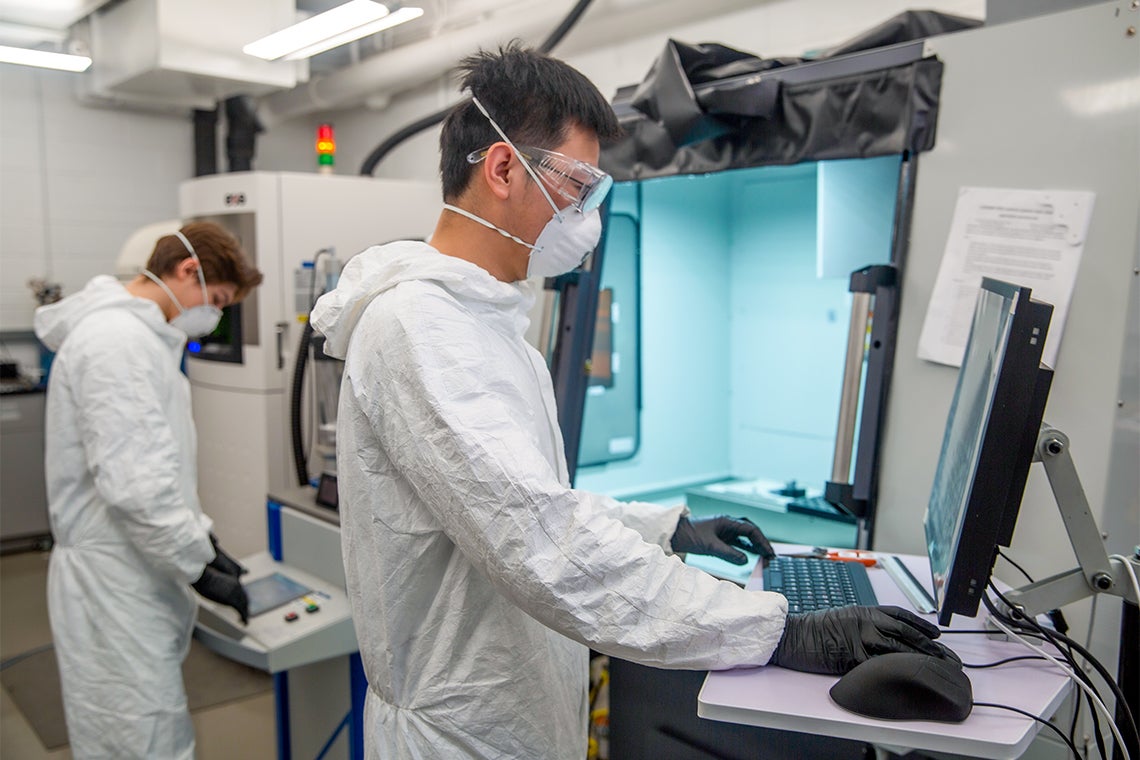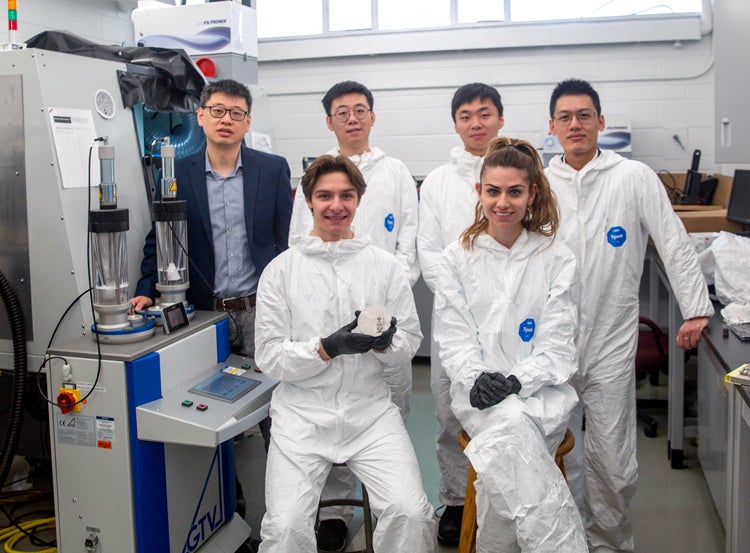
A team of University of Toronto researchers, led by Professor Yu Zou in the Faculty of Applied Science & Engineering, is working to advance the field of metal additive manufacturing at the university's first metal 3D printing laboratory.
The technology, which uses computer-aided design (CAD) to construct materials layer by layer, can improve manufacturing across aerospace, biomedical, energy and automotive industries.
"We are working to uncover the fundamental physics behind the additive manufacturing process, as well as improving its robustness and creating novel structural and functional materials through its applications," says Zou, an assistant professor in the department of materials science and engineering.
Unlike traditional manufacturing, in which parts or components are made from bulk materials, the metal 3D printing process enables microstructure and materials constitutions to be locally tailored, meaning they can exhibit distinct properties.
"For example, medical implants require human bone-like materials that are dense and hard on the outside, but porous on the inside," says Xiao Shang, a PhD candidate in Zou's lab. "With traditional manufacturing, that's really hard to accomplish - but metal printing gives you a lot more control and customized products."
Subtractive manufacturing techniques generally involves removing material in order to achieve a desired end product. Additive manufacturing, by contrast, builds new objects by adding layers of material. This process significantly reduces production time, material cost and energy consumption when producing objects such as aerospace engine components, tooling parts for automotive production, critical components for nuclear reactors and joint implants.

Assistant professor Yu Zou, far left, and his 3D printing team conduct research in the Laboratory for Extreme Mechanics & Additive Manufacturing (photo by Safa Jinje)
Zou's metal 3D printers are designed to specialize in both selective laser melting and directed energy deposition - two essential metal additive manufacturing techniques used in both academia and industry.
First, CAD software is used to create a 3D model of the object and its layers. Then, for each layer, the machine deposits a very thin layer of metal powder, which is subsequently melted by a powerful laser according to the geometry defined by the 3D model.
After the molten metal solidifies, it adheres to either the previous layer or the substrate. Once each layer is complete, the machine will repeat the powder doping and laser melting process until all layers are printed and the object is completed.
"Conventional manufacturing techniques are still well-suited for large-scale industrial manufacturing," says Tianyi Lyu, a PhD candidate in materials science and engineering. "But additive manufacturing has capabilities that go beyond what conventional techniques can do. These include the fabrication of complex geometries, rapid prototyping and customization of designs, and precise control of the material properties."
Three different geometries are fabricated layer by layer using the directed energy deposition process (video by Xiao Shang)
For example, dental professionals can use selective laser melting to create dentures or implants customized to specific patients via a precise 3D model with dimensional accuracy that is within a few micrometres. Rapid prototyping also allows for easy adjustments of the denture design. And since implants can require different material properties at distinct locations, this can be achieved by simply changing the process parameters.
The team is also applying novel experimental and analytical methods to gain a better understanding of the selective laser melting and directed energy deposition printing processes. Currently, their research is focused on advanced steels, nickel-based superalloys and high-entropy alloys, and they may expand to explore titanium and aluminum alloys in the future.
"One of the major bottlenecks in conventional alloy design today is the large processing times required to create and test new materials. This type of high-throughput design just isn't possible for conventional fabrication methods," says Ajay Talbot, a master's student in materials science and engineering.
With additive manufacturing techniques such as directed energy deposition, the team is rapidly increasing the amount of alloy systems explored, altering the composition of materials during the printing process by adding or taking away certain elements.
"We are also working towards intelligent manufacturing. During the metal 3D printing process, the interaction between a high-energy laser and the material only lasts for a few microseconds. However, within this limited timeframe, multi-scale, multi-physics phenomena take place," says Jiahui Zhang, a PhD candidate in materials science and engineering. "Our main challenge is attaining data to capture these phenomena.
"In our research, we have successfully customized specific machine learning methods for different parts of the metal additive manufacturing lifecycle."
In the lab, high-speed infrared camera systems are integrated directly into the metal 3D printers. The team has also built an in-situ monitoring system based on the images taken by the printer to analyze and extract the key features of printed objects.
"With the development of computer vision, a well-trained deep learning model could automatically accomplish some basic tasks that human visual systems can do, such as classification, detection and segmentation," adds Zhang.
One of the problems with current additive manufacturing processes is building a robust and reliable 3D printer that can deliver consistent high-quality parts. To this end, the team is actively working to apply machine learning and computer vision to develop a fully autonomous closed loop-controlled 3D printing system that can detect and correct defects that would otherwise emerge in parts made via additive manufacturing. Implementing these systems could greatly widen the adoption of metal additive manufacturing systems in the industry, says Zou.
Since building up the lab's metal printing capabilities, Zou and his team have established partnerships with government research laboratories, including National Research Council Canada (NRC) and many Canadian companies, including Oetiker Limited, Mech Solutions Ltd., EXCO Engineering and Magna International.
"Metal 3D printing has the potential to revolutionize manufacturing as we know it," says Zou, who offers an additive manufacturing course that is available to both undergraduate and graduate students. "With robust autonomous systems, the cost of operating these systems can be dramatically reduced, allowing metal additive manufacturing to be adopted more widely across industries worldwide.
"The process also reduces materials and energy waste, leading towards a more sustainable manufacturing industry."






